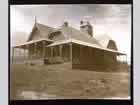As women and children continued to arrive at the diggings to join their menfolk, schools became visible in the landscape. In January 1852, there were an estimated 5000 women and children at Victoria’s diggings, with the figures substantially rising in the following months. Associated with churches and religious services that had quickly sprung up, Sunday schools were the first informal teaching bodies on the goldfields. Providing education on religion and morality to children, classes were initially held outside, or within a tent that served as a church. While the diggings sought to establish secular classrooms, schooling was not a frequent or regular occurrence for many of Victoria’s children. Serle estimates that less than a quarter of Victoria’s school-aged children actually attended regular classes in 1851 – mobility, poor weather, and a lack of resources and venues, made regular attendance difficult for many.
Ballarat’s first primary school was established in the heavily Irish populated community of Eureka, in April 1853. Within the slab and bark building, the non-denominational school taught 55 students, 47 of whom were Irish. Following a dispute, a Roman Catholic school was started nearby but initially failed to recruit pupils. In June 1853, a national school (the forerunner of the state primary school system) was formed at Soldiers Hill, but although it had an enrolment of 450 children, only 137 attended. In 1856, Ballarat’s first grammar school was opened in Doveton Street.
After four months of agitation, Mount Alexander’s first national school was opened at Forest Creek, in 1853. Another national school, five miles away – at Fryers Creek – soon followed. At first, both schools were housed in tents, with the words ‘National School’ painted across them. The tents were practical as they could be quickly disbanded and transported elsewhere if the population and its students suddenly left for more prosperous diggings. The school day was broken into two sessions, with the first held from 9 am to 12 midday and the second from 2 pm till 5 pm. Every night, adults could receive an hour of free schooling.
Initially, schools found it very hard to establish themselves. The doubling up of national and denominational schools meant educational institutions were not only competing for pupils, but also for resources and funds, which were thereby spread out so thinly that each school received too little to be of much benefit. Even with fees heavily subsidised (the government paid two-thirds of the tuition fees and parents paid the remaining third) schools continued to experience difficulties. Quality teachers were difficult to both find and retain at the diggings, which provided unique challenges for the institutions. Not only did they have to contend with few resources and a highly itinerant population, but they also had to instill the values and benefits of education and knowledge into a society mad with the obtainment of instant wealth. In acknowledging this, the Victorian Gold Fields’ Commission lamented: ‘the situation of a teacher there has too many hardships and disadvantages to prove attractive to a high order of ability. His methodical vocation contrasts widely with the surrounding excitement and uncertainties of gold-digging.’


